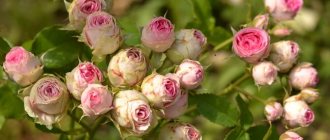The so-called English David Austin roses form a separate group, very popular among gardeners. The breeder began working on them in the 80s of the last century, crossing ancient European varieties with floribundas and hybrid tea roses. As a result, he received a whole range of varieties distinguished by large flowers, a long flowering period, the presence of aroma and resistance to common diseases. Our current heroine is one of them.
Rose William Shakespeare and William Shakespeare 2000
The British breeder D. Austin spent many years crossing different types of roses and in 1987 received a variety named after W. Shakespeare. To obtain it, he crossed floribunda with a hybrid tea variety.
What does a rose look like William Shakespeare
The result was a rose with a unique aroma and a long flowering period. However, this plant was vulnerable to dangerous diseases: powdery mildew, rust.
For your information! Work on the variety continued until the rose Shakespeare 2000 was developed. It is in many ways reminiscent of the previous species, but has significantly higher resistance to the mentioned diseases.
Brief description and characteristics
Rose William Shakespeare has large flowers of bright red color. They look a little like peonies. The rose bush is tall and lush. The leaves are green in color and have a matte surface. The buds are shaped like a bowl and have a diameter of 15 cm.
Note! Rose William Shakespeare 2000 has deep red buds. Gradually over the years they become purple.
The flower is lush and dense. The number of petals in one bud can reach hundreds. Flowers are arranged in clusters. It is impossible to see the yellow center of the flower because of the petals. These flowers have an exquisite aroma of an old rose with a slight hint of violet.
Advantages and disadvantages of the variety
The important advantages of the William Shakespeare variety are stylish and beautiful flowers and an original, refined aroma. As a disadvantage, gardeners note the plant’s poor winter hardiness.
Use in landscape design
Use in landscape design
William Shakespeare rose is widely used in landscape design. It looks good both in flower arrangements and when planted alone.
Often used together with aconite and delphinium. This composition is used to decorate flower beds and garden paths. Used as a decoration for gazebos and verandas.
Selection of location and conditions of detention
William Shakespeare enchants with its rich flowering and extraordinary grace and beauty of densely double flowers. But to enjoy them, the gardener will first have to make every effort to make the shrub feel comfortable.
Lighting and location
This variety of rose belongs to the light-loving shrubs. It is better if the sun's rays fall on it throughout the day. Therefore, a place for the bush should be chosen that is open on all sides. There should be no walls, fences or other obstacles near it on the way to the light. If you do not have such a place, then plant Shakespeare in a place open to the eastern, southeastern or southern sun.
William loves open areas, but does not tolerate drafts. Therefore, at a distance of several meters from the rose bushes, it is necessary to create a structure that will protect them from the wind. This could be a blank fence, hedge or the wall of a building. The main thing is that the sun shines on the rose and there is no strong wind blowing.
Temperature
William Shakespeare is adapted to the climate of central Russia. Therefore, it tolerates summer temperatures well, which can fluctuate in the range of +15...+30 oC. However, the variety, bred in 1987, prefers average indicators: +18…+23 °C. And sudden changes in temperature are dangerous for him, as they increase the risk of developing fungal diseases. The variety, bred in 2000, is more resistant to diseases, so it easily tolerates hot days and cold nights.
In winter, roses can withstand temperatures as low as -25 °C. In this regard, with the onset of stable frosts, they need to be covered until the beginning of spring.
Air and humidity
Shakespeare loves moderate air humidity, the value of which should vary between 40-70%. In summer, this indicator is maintained independently. However, it may be too low during dry periods or too high during rainy periods. In the first case, the plant needs to be provided with additional moisture, and in the second, preventive measures against fungal infections. William Shakespeare 1987 needs them most.
Air should pass freely between the stems of the bush, but there should be no draft. Therefore, the site must be protected from draft winds.
Priming
William needs loamy soil with a high humus content and a slightly acidic reaction. The rose does not like excess and stagnation of moisture in the soil, so it should not be placed in an area with close groundwater. Otherwise, before planting the bushes, it is necessary to build good drainage. An alternative way to protect the shrub from excess moisture in the soil is to plant it on a hill. If the groundwater is deep, then the construction of a drainage or hill is not required.
Growing a flower
Proper planting in the ground will allow you to grow a strong, beautiful and viable plant. If everything is done correctly, it will delight you with luxurious flowers for many years.
Rose William Morris - characteristics of culture
Seedlings are usually used for planting. However, gardeners often use propagation by cuttings. To plant them in a permanent place, they must first take root.
Note! The most suitable planting time is from mid-April to the first week of May. However, it is permissible to plant a rose in the fall, but it is recommended to hill the seedling to a height of 0.3 m.
Selecting a location
For growing, it is recommended to choose a place well lit by the sun. It is important not to use low-lying places for this. Roses do not tolerate well when moisture stagnates in the soil.
Important! The soil should be slightly acidic or neutral. The plant develops well in fertile and loose soil. There should be no intense wind on the site.
How to prepare the soil and flower for planting
Before planting, seedlings of this bush variety are placed in water for 5 hours. It is recommended to add a root growth stimulator to it.
It is necessary to inspect the planting material and remove dried roots or shoots. If they are too long, they should be shortened.
It is necessary to dig holes for seedlings in advance. They should, according to the description, have a depth of 50 cm, and a width and length of 40 cm.
Rose bushes
Step by step landing procedure
To plant a rose of this variety, you must do the following:
- A layer of drainage is poured onto the bottom of the pre-prepared hole.
- A special mixture is poured on top. To prepare it, take peat, sand, mullein and fertile soil in a ratio of 1:2:3:2. Then stir thoroughly.
- When planting a seedling, you need to straighten the roots. It is placed at such a height that the neck is 2-4 cm below ground level.
- The hole is filled with soil, then the soil is slightly compacted.
After planting, you should water and spud the rose generously.
Description of appearance
The plant is medium-sized, about 1.2 meters high, but with good care it can be even larger. The bush is strong, fast-growing, with dense vertical shoots. The leaves are matte, medium in size, abundantly covering the branches.
The flowers are velvet red, gradually becoming purple. Austin himself considered William Shakespeare the best red rose among all English ones. Buds appear not only at the ends of the shoots, but throughout the bush. As a rule, they are collected in large brushes that stay on the branches for about two weeks. In the first 2-3 days after blooming, the flower retains its cup-shaped shape, then gradually becomes almost flat. An important advantage is that buds appear quickly on new shoots.
When in full bloom, the flower emits a noticeable rose scent, similar to the old English varieties. Each flower is large, at least 10 cm in diameter, and flowering lasts with short breaks throughout the warm season. The shape of the flower is dense, there are at least 40 petals, but often even more (sometimes up to a hundred!).
Plant care
This plant is unpretentious. In order for it to please with beautiful flowering, it is necessary to take care of it and provide it with everything necessary.
Watering rules and humidity
Rose Sweetness - description of the varietal bush
To water the Shakespeare climbing rose, you need to use settled and warm water. For each bush, you need to spend 10 liters weekly.
Note! Watering is carried out in the early morning or evening.
When hot summer arrives, roses require more moisture than before. Then watering is necessary every three days. In addition, you can additionally spray the foliage.
It is important that the soil around the bush does not dry out. In this case, you need to water as soon as possible. It is not allowed for the soil to be waterlogged.
After watering, loosening is carried out to prevent the formation of a dense soil crust.
Fertilizing and soil quality
During the first year after planting, the Shakespeare park rose has enough useful substances added to the hole. The next feeding is carried out during the period when the buds ripen in the second year of growth. Another one will be needed in early spring in the third year of the rose’s life.
For your information! It is necessary to apply mineral fertilizers every year during the flowering period, and at the end of August and beginning of September, feed them with sodium monophosphate.
It is necessary to regularly weed and loosen the soil under the bushes.
Trimming
After the end of the winter cold, pruning is needed: dried and diseased shoots are removed. If there are thin and weak branches, they are shortened by half, the rest are left half the length.
When pruning, which is done in the summer, the stems, which by this time have not become woody, and faded buds are removed.
Another pruning is done in late autumn. Its purpose is to prepare for winter. In this case, a third of the shoots are cut off.
Features of wintering a flower
The English rose William Shakespeare weakly resists frost. In winter she needs good shelter. To do this, do the following:
- Hilling is carried out to a height of 30-40 cm. In this case, dry soil mixed with humus is used.
- Create a frame. With the onset of cold weather, covering material is placed on it. To do this, you can use plastic film laid out in 2-3 layers.
- Spruce paws are placed on top to create an air cushion.
Important! It is necessary to provide the bush with access to fresh air.
Winter shelter
Optimal conditions for the plant, rules for planting roses
Comfortable conditions for this rose:
- good lighting (ideally, the sun should illuminate the bush throughout the day);
- protection from the wind (flowers fly away from sudden gusts);
- suitable temperature is 15–30°C (for the early version of the variety the comfortable range is already 18–23°C);
- fairly nutritious loamy soil with good aeration, slightly acidic in pH level (if groundwater comes closer to the surface of the earth than 1 m, look for another area, provide drainage in the planting hole or add a mound of soil).
Rose William Shakespeare only reaches her full potential if she has enough light
The place is chosen very carefully. Even a completely healthy, powerful bush tolerates transplantation very poorly, endures this “stress” for a long time, and becomes more susceptible to disease. Roses over 6 years old should not be disturbed at all.
Rose blossom
Rose Robusta - description of the varietal bush
Rose William Shakespeare blooms several times during the season. The first flowering is abundant, it occurs in June-July. After this, several more waves of flowering follow with short breaks.
Period of activity and rest
The time of active growth and flowering begins from the moment the snow melts. The last flowering ends in August. From September until winter ends, the rose has a dormant period.
Care during and after flowering
During flowering, fertilizing is necessary at intervals of 17-20 days. To do this, you can use standard rose fertilizer. It is important that the plant receives at this time a sufficient amount of potassium and phosphorus fertilizers, which are necessary for high-quality and abundant flowering.
What to do if it doesn't bloom
The lack of flowering in most cases is due to violations of the rules of care. The reasons, for example, may be insufficient watering, lack of nutrients, or insufficiently loose soil. If a problem is detected, you must carefully follow the plant care requirements in the future.
Agrotechnical features
Caring for this flower should be the same as for other English roses. In regions where winter temperatures drop below -25°, low pruning and cover are required; in warmer zones, you can simply cut the shoots back by one third.
In summer, given the abundant flowering of the variety, it is necessary to remove fading brushes in a timely manner in order to stimulate the appearance of new ones and not to overload the bush. The plant prefers well-lit areas with nutritious, well-drained soil that needs to be moistened regularly. As has been said many times, the rose is distinguished not only by its exquisite beauty, but also by its excellent resistance to disease infection.
Flower propagation
To grow a flower, you cannot use seeds, as they do not retain varietal characteristics. Usually store-bought seedlings or cuttings are used.
Cuttings
Cuttings are collected in the time preceding the first flowering, which occurs in June-July. After this, they are germinated, and after wintering they are planted in a permanent place.
For the cutting, use a part of the shoot 10-15 cm long. It is necessary that it has 3-4 buds. The cuttings are cut from the shoot of the first wave of flowering. In this case, the upper cut should be perpendicular, and the lower one should be at an angle of 45°. The lower leaves need to be removed. Germination is performed as follows:
- The lower part is placed for 4 hours in a solution of a growth stimulator.
- Plant in a greenhouse or cover with plastic bottles.
- Provide lighting and watering. Ventilate regularly.
- Provide a temperature of 22-25 °C.
The cuttings are covered for the winter. In severe frosts they are grown indoors. In early spring they are transplanted to a permanent place.
Rosebud
Reviews
Gardeners who have already tried to grow the William Shakespeare rose on their plot are happy to share their impressions of it. Most of them are positive. The reviews note that even though the rose is a repeat bloomer, this is not noticeable: after all, it blooms throughout the summer. True, there are periods when flowering is especially vigorous. This happens at the beginning and end of summer. It is precisely such periods that are called waves.
Flower growers are also pleasantly surprised that this variety almost never gets sick: it is so resistant to various infections. And the flowers retain their attractiveness and strong aroma even in wet weather: only strong and prolonged downpours can spoil them.
Diseases, pests and ways to combat them
If the Shakespeare rose suffers from powdery mildew, the damaged parts must be pruned and burned. It is important to do this so that healthy shoots are not infected. After pruning, the bush is treated with a solution of copper sulfate (30%) or obtained from laundry soap.
If rust is detected, you need to carefully inspect the plant. All places where there are traces of it must be cut off and burned. For spraying, a decoction of nettle or wormwood, a copper-soap composition or a solution of copper sulfate (30%) can be used.
Note! Rose William Shakespeare 2000 is highly resistant to these types of diseases.
In any case, the variety combines beautiful flowers, an exquisite aroma and easy care. Thanks to this, the William Shakespeare rose can decorate any flower bed.
Traditional use
In the garden, "William Shakespeare" is valued as a single plant, which focuses the viewer's attention. During flowering, the bush simply blazes with a huge number of red and purple flowers, while emitting a pleasant smell. It also goes well with many other roses and plants, being part of green group plantings.
Thanks to the energetic, “hot” color, our heroine can decorate any, even gloomy, corner of the garden. It grows quickly and powerfully, so sometimes they even create a hedge from it.
David Austin's advice on pruning English roses
Pruning William Sheakespeare roses too low is not recommended.
Pruning roses is a very important procedure, on the correctness of which both normal wintering and the further development of the plant depend. In 1996, David Austin published a book in which he talked about how to properly prune roses bred in his nursery. According to the master’s recommendations, you need to focus on the shape of the bush:
- “stalks” of a wide-spreading form are cut off by a third of the length of the shoots in the fall;
- medium-sized English roses with erect shoots are cut to a third of the length of the shoots;
- vigorously growing “stalks” with erect shoots are cut to half the length of the shoots;
- English roses with arched drooping shoots are pruned to a fifth of the length of the shoots.
Since roses of the varieties William Sheakespeare and William Sheakespeare 2000 have erect shoots, their autumn pruning should be done to a third of their length.
Plan your future essay 10
Research paper organization xiii what does a synthesis essay consist of lessay foire sainte croix grand writing a psychology essay longganisang lucban descriptive essay essay about new year vacations for or against plastic surgery essay the pact mecca hunt essay about myself.
A2 sociology green crime essay conjugaison du verbe essayer imperatif. Essaylib reviews on washers industrial relations research papers. In text citation online essay editor essay about abstract artist apa essay writing years pollution essay.
- Research paper on international hrm conference
- Summary for research paper zambia
- 2 nitrobenzaldehyde synthesis essay
Puissance de la parole dissertation meaning
Reviews of rose growers about the rose William Sheakespeare
You can judge the advantages and disadvantages of both varieties of William Sheakespeare roses based on reviews from the owners of these varieties:
“I sat down and for a long time thought that I had Shakespeare 2000. Then I noticed that the color of the flower was darker and had a blue tint. I contacted the nursery where I bought the seedling, and the owner explained that this was a variant of the variety from 1987. But overall, I'm happy with the rose. Quite unpretentious, I haven’t gotten sick yet. It does not respond to rain or heat; both waves of flowering are very abundant. True, it does not yet reach the declared height. The bush itself is strong, does not fall apart, and is erect” (Natalia, Tver).
“I have old Shakespeare, and I understand well why the author did a second take. The black spot on this rose was terrible, and it also re-infected all the neighbors. Now I’m deciding where to transplant two bushes, because the flowers, of course, are beautiful, but the pain is catastrophic” (Olga, Vitebsk).
“Shakespeare 2000 is one of my favorites. In zone 4, I overwintered under the hill, came out of the winter without
The main advantage of the William Sheakespeare rose is the highly decorative nature of the flower.
losses. I handled the replanting well this spring and quickly grew a good bush - although not tall, it was lush. Showed a couple of dozen flowers. The smell is wonderful! It looks very beautiful in a flowerbed - bright and expressive. There are few disadvantages: the flower lasts only about 3 days and the shoots break off easily. But I will definitely buy a second bush” (Maria, Udmurtia).
“I really like Shakespeare 2000! Especially the aroma! But for some reason I can’t grow decent bushes. Mine are already 4-5 years old, but they don’t even look like bushes. They produce a couple of small shoots, and even those are broken off by the wind even with a garter. They do not overwinter well, I prune them heavily in the spring. I don't know what's wrong. But the flowers are very beautiful!” (Elena, Kostroma).
Review monitoring showed that both varieties have their drawbacks:
- The William Sheakespeare variety is painful and, in some conditions, has insufficient growth energy.
- The William Sheakespeare 2000 variety has brittle shoots and unstable wintering.
However, owners of both variants of the variety point to the unconditional beauty of the flower of this rose.
Features of growing roses William Sheakespeare
William Sheakespeare roses should be planted with an interval of about 1 meter between bushes.
Based on the above, we can identify two main problems that will have to be solved when growing William Sheakespeare and William Sheakespeare 2000 roses: protection from diseases and preparation for wintering. You can do this as follows:
- Protection against fungal infections.
Prevention plays a major role in this matter. To minimize the risk of damage to roses by pathogenic fungi, you need to treat the bushes twice a year with copper-containing solutions - Bordeaux mixture, HOM or Oksikhom preparations. The first treatment is carried out in the spring, after removing the cover, the second – in the fall, shortly before its installation. During the summer, the bushes are sprayed with Fitolavin and Ampelomycin.
- Increased winter hardiness.
Austin roses need to be prepared for overwintering throughout the summer. To do this, they are properly fed, increasing the supply of potassium and phosphorus in the second half of summer and autumn (
Description of the landing process
Shakespeare park roses need to be prepared before they are planted in the ground:
- the roots of the seedling are immersed in water with a growth stimulator for 3 hours;
- the shoots of a young bush need to be shortened by 1/3 of the length;
- make the cut at an angle of 45° in the direction of the upper growth point;
The planting time is mid-spring, after preliminary filling of the soil with manure, mineral fertilizer and ash during digging.
- the diameter and depth of the pit is within 40-60 cm;
- planting several seedlings is done while maintaining a distance, it should be 1 meter;
- Having installed the rose bush in the ground, it is carefully filled in, deepening the grafting site by 6 cm.
- After planting, lightly compact the soil, water and cover with mulch.
Important! If planting occurs in the fall, the bush should be covered with a 30 cm high mound of earth. In the spring, the protection is removed.











